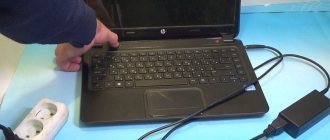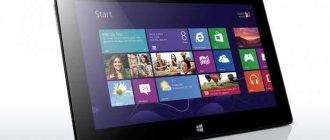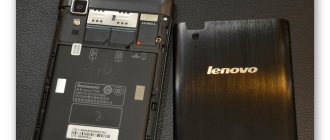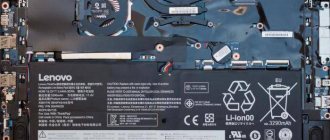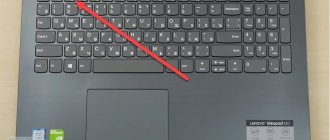Computers are eternal mysteries for users. It is very difficult to predict whether a particular machine will actually work properly for a long time. No one is immune from failures and malfunctions. What should you do if you find that your Lenovo laptop won’t turn on? Why might this happen? The best tips and tricks will be presented below. Understanding all this is not so difficult if you use the method of elimination. Quite often, users immediately take the laptop to service centers. There is no need to do this. It is likely that the problem can be resolved without outside help. So what options are there?
No battery
Lenovo laptop won't turn on? It is likely that the device simply does not have a battery. This situation is relevant when it comes to working with a device without connecting it via a wire to the network.
Correcting the situation is easy and simple. It is enough to insert the battery into the laptop, into its lower part. The user will see a special niche on the panel. The missing part of the laptop is inserted into it. You can then resume using your device. No results? Don't despair! There are still a lot of options!
Creating a custom backup
In principle, you can take care of creating a backup in advance, and it is not at all necessary to use Windows tools for this. Such tools are also available in the built-in utility.
For example, for Windows 8.1, you can initially select to launch the pre-installed OneKey Recovery application from the list of programs, after which you either agree to save a copy in the section offered by the utility itself, or specify a different path.
To launch a system rollback from a user backup when calling the recovery tool described above, when selecting a recovery task, you will need to specify not the original copy, but your own, using the browse button to access it and select the Backup.wsi file. In this case, unlike the first option, neither disk partitions nor user data will be deleted.
Battery charge
How to turn on a Lenovo laptop if the battery is inserted, but the device still does not want to work? It cannot be ruled out that the battery has no charge. In this case, you will not be able to work on a laptop without additionally connecting it to the network.
It is enough to connect a special power cord to the machine and then plug it into a power outlet. And then wait a little. The light on the front panel of the laptop should light up indicating the battery charge. A little wait (usually a few hours) - and you can work with Lenovo without additional wires. True, until the battery runs out again. As practice shows, an average charge lasts for 4 hours.
How to run Lenovo system recovery using built-in tool?
Now let's move on to considering the reset process. First, let's look at system recovery on the Lenovo IdeaPad, Essentials, and models like the G50.
On all such devices, next to the power button or on the side panel there is an additional button, which is responsible for calling the system reset tool without using any removable media or tools from an existing working or even damaged operating system. To begin system recovery on the Lenovo G50 or other similar models, you first need to turn off the laptop completely, and then press the same Novo Button instead of the power button to launch the built-in tool.
Nutrition
The next reason is somewhat similar to the situation with a laptop battery. Laptop refuses to turn on? It cannot be ruled out that there is no connection to a power source in principle. Why is this layout highlighted as a separate item?
The fact is that some Lenovo laptops are equipped with a built-in battery. It is located under the bottom panel and cannot be removed easily. In this case, it is recommended to find the power cord and plug it into the network. And then connect it to the device.
If there is no power, the machine will turn on and work. Still no progress? Lenovo laptop won't turn on? What other situations occur? How to deal with them?
What is important to know before starting a rollback or hard reset?
Before proceeding with a direct description of the reset, it should be noted that on different models of Lenovo laptops, system recovery in terms of the actions performed may differ slightly. Firstly, the toolkit itself can be called differently (OneKey Recovery, OneKey Rescue System, etc.). In most cases, such built-in utilities are available on almost all devices of the IdeaPad line or G series. But on ThinkPad devices, this procedure is quite different (we will dwell on it separately).
Wires
For example, the whole issue may be a damaged power cord. Such situations are especially relevant for older laptops. Or if the device's power cord is frequently used/pinched/exposed to external influences. It is very problematic for the user to diagnose such a problem.
If there is a similar power cord, it is recommended to connect it to the laptop and then try to turn it on again. Otherwise, it is better to take the device with all components to a service center. They will quickly help you sort out the problem.
Another alternative solution is to purchase a new power supply cable for a laptop of one model or another. The new component will 100% work. Accordingly, the computer will turn on. But what if there is no progress even after replacing the wire?
System recovery on ThinkPad series models
Now a few words about restoring the Lenovo ThinkPad system. Here the actions are somewhat different from what was presented above.
To access the recovery environment at the boot stage of the laptop, you need to press the F11 key, select the desired language, click the continue button, enter the user password (if set), and then activate the Lenovo Factory Recovery item in the menu that appears. Next, a process begins that is very reminiscent of a regular Windows installation. At one stage you will need to agree to the restart, and then set the necessary parameters.
Laptop connectors
Lenovo laptop won't turn on? What to do in this case? When all the previously listed options have been excluded, you will have to pay attention to other nuances. Let's say, on the connectors for connecting power to the device.
The fact is that sometimes the sockets on laptops get damaged. This reason is practically excluded on new computers, but is more common when it comes to older devices.
The service technician helps fix the problem. They will not only help you understand whether the problem is really with the connectors, but will also fix them. Only in some cases will you have to buy a new laptop.
How to save data on a phone that won't turn on
There are different ways to save data on your phone, from the simplest, such as cloud services, to the most complex, such as transplanting a memory chip.
The last method must be carried out only by professionals, since any work with microcircuits in the phone can be the last in inexperienced hands.
Cloud storage
Cloud storage is also an excellent option, but it only works if the user has previously configured synchronization for such a case. If not, then it will not be possible to completely restore the data. For more information on how to connect cloud storage to your phone, watch this video
Programs
If there is a need to get files from the internal memory of the phone, then there are special utilities for such purposes. For example, the DiskDigger program works on this principle.
The application is free, available for download through the Play Market, and is designed specifically for these purposes. All you need to do is download it and connect the device to your computer via a special cable. The utility will automatically detect the phone, and then offer an algorithm that can be used to completely clean the file transfer system. It works with almost all popular data formats, so transferring them and then downloading them back to a new phone will be completely easy and simple.
Video card
What other options might there be? All the previously listed scenarios are very common phenomena. But they are quickly excluded. What should I do if my Lenovo laptop displays a black screen? It is important to pay attention to what is happening to the device as a whole.
For example, when the cooler is running. And it’s normal - it doesn’t make loud noise, it performs its functions. In fact, the laptop turns on, but there is no image on the screen. What to do then?
It's worth checking the video card. It is likely that it is faulty. A black screen instead of a computer or laptop being turned on is a very common occurrence when problems arise with a video card. For unknowing users, it is better to use the services of a service provider to test the theory. After all, you can easily damage the remaining components of the laptop. After repairing or replacing the video card, the problem should go away on its own.
Trouble-shooting
In this section, we will look at the most common faults that cause Lenovo to not turn on:
- Complete battery discharge and other related battery problems.
- Firmware update failures.
- Software problems.
- Virus attack.
- Mechanical damage to internal parts.
Battery completely discharged
Battery problems can be temporary or permanent, and they have different solutions:
- Temporary problems can include the following options: Faulty charger. As a rule, it is detected very quickly when, upon contact with the wire, the phone does not indicate the charging process. You just need to buy a new cord and adapter, and everything will fall into place. If your phone is completely discharged and you don’t know exactly what the problem is: test the equipment on another gadget. It is better not to buy cheap chargers from unknown manufacturers. In addition, pay attention to the current-voltage characteristics (they are written on the block). Unsuitable equipment can quickly kill a battery.
- Disorders in operation at high and low temperatures. Phones always turning off in the cold are practically a classic, and you need to be prepared for such situations. Read the user manual, they often indicate the range of “operating” temperatures and operating rules under different weather conditions.
- Oxidation of contacts with the battery.
Incorrect system update
From time to time, the Android OS firmware and its shell are updated, but glitches may occur during the process. Often, after installing a new version of the system, equipment turns into a non-working “brick”. However, do not rush to replace it with another model; this can be solved by rolling back to factory settings.
It is done using Recovery Mode. Three buttons are pressed simultaneously in the following sequence:
- Volume rocker.
- Without releasing the previous one, return to the Desktop key.
- In parallel with them there is a power on and off button.
A menu will appear on the screen. The pointer moves with the volume rocker up and down respectively. You must select Factory Reset, confirm your choice and wait for the process to complete.
If after this the smart device does not work, then you need to contact a specialist, and he will do the flashing of the system himself.
Software glitches
Even more often, Android-based cell phones do not start due to various kinds of software glitches. The manufacturer and system developers have provided for such scenarios, so they advise resetting the settings in such cases. We have already discussed how to do it above.
Please note that pressing the keys in succession will not work to start recovery mode on some models. It is started by a special button on the end of the case, which looks like a small hole, using a needle or a special pin that comes with the kit.
Viruses
Viruses are another popular reason for difficulties with Android technology. They arrive by downloading files and applications from unknown sources, and can seriously damage system data necessary for startup. Most likely, a flashing will be required, which will completely delete the information. But in some cases, service center specialists still undertake manual cleaning of the system storage from viruses and malware.
You can avoid this outcome by first downloading anti-virus software, for example, Dr.Web or ESET.
Mechanical damage and moisture ingress
Let's look at the most popular types of mechanical damage that prevent switching on:
- Screen failure (malfunction of the cable, display, or moisture ingress through the seams).
- The charging socket is dirty. Dust, fabric threads from clothes or crumbs get into it. You need to clean the connector carefully, using a regular needle.
- Damage to gadget contacts with batteries. This can be either oxidation or mechanical stress that led to deformation.
- Damaged power button. If the device is new, then most likely it is a factory defect.
- The worst option is a burnt-out power controller that controls charging.
RAM
Lenovo laptop won't turn on? What to do? A similar situation cannot be ruled out due to an equipment conflict. For example, video cards and RAM. Or the RAM has broken down altogether. Relevant for old laptops or those that have been modified to one degree or another. Especially when the user independently went through the hardware of the device.
As a rule, if the problem lies in the RAM, the laptop will emit a certain signal when turned on. It is impossible not to hear him. Everything can be solved either by repairing the laptop (the computer is taken to a service center, then the working gadget is taken away), or by purchasing a new device.
BIOS
What circumstances can affect the performance of Lenovo? There are many reasons for this problem. And identifying them on your own is not as easy as it seems. What to do if your Lenovo laptop doesn’t want to work? The monitor does not turn on, although everything is fine with the hardware, the power cord, connection connectors, and the battery are also normal. Why are problems not eliminated?
It is likely that the whole point is in the design of the computer system. A faulty or damaged BIOS quite often brings a lot of problems to users. In this case, the computer may not turn on, simply reboot, turn off on its own and not save what was done while working with the device.
The only thing that helps here is reinstalling and reconfiguring the BIOS. This is usually done by system administrators, as well as service center employees. It is not recommended for the average user to mess with the BIOS on their own. It is possible that an inept reinstallation will turn a Lenovo laptop into a pile of useless metal. Fortunately, this happens extremely rarely.
HDD
It also happens that, despite the fact that the Lenovo laptop turns on, the OS does not boot or is constantly rebooted. Then you need to make sure the hard drive is working. If it is missing or in a faulty condition, there is nothing to be surprised about. In fact, the gadget works, but there is nowhere for it to load the operating system.
An extremely rare occurrence. It can be easily diagnosed by contacting service centers. In this situation, the laptop needs to be supplemented with a hard drive that will work properly. The operating system is installed on it, after which a second attempt to work with the device occurs. Everything is fine? Then you don’t have to worry about the integrity of the laptop and its further operation. Still no result? Lenovo laptop won't turn on? Other situations cannot be excluded. Which ones specifically? What else is recommended for users to pay attention to?
Step by step description of the reset process
After turning on the computer device in this way, a menu for selecting actions appears on the screen, in which from the presented items you must use System Recovery or OneKey Recovery (depending on the model). Next, a special task selection menu appears with two items.
We assume that the user did not create his own backup copy, so we select the option to restore the Lenovo system from the original backup for the G50 model. After this, you need to agree to the warnings about starting the reset and deleting all user data. Next, the recovery process itself starts, and upon completion, you will need to click the “Finish” button, after which you can also select a reboot in manual mode, since an automatic restart option is simply not provided here.
But that's not all. The next step in Lenovo system recovery involves entering data and selecting options, just as you would when installing an operating system. But on IdeaPad devices you do not need to perform such actions. On these devices, the reboot will be performed automatically after the reset is completed, and you will end up with a “clean” system, as it was when you purchased the laptop.
Turned on and off
Sometimes a computer or laptop turns on and then turns off. Or it constantly reboots. There is no need to be afraid of such circumstances. You need to pay attention to the operation of the cooler. Is it not working or is it functioning normally?
In any case, if a Lenovo laptop (or any other) starts to turn off spontaneously or reboots constantly, you can come to the conclusion that the culprit is simple overheating of the equipment.
It occurs for various reasons. One of them is a clogged cooler. Any laptop needs to be cleaned from time to time. And the cooler of the device too. It is necessary to take all possible actions to eliminate overheating. For example, clean the fan or replace it altogether. It is also worth paying attention to the position of the computer - the laptop should not be positioned in such a way that access to oxygen in the cooler area is blocked. All this will help restore the functionality of the gadget.
Sleep mode
You can also simply not turn off the laptop, but leave it in sleep mode. To set this mode, follow the instructions:
- Follow the chain: Start -> Control Panel -> Power Options.
- On the left, select “Sleep Settings.”
- Now you need to set the sleep time when working from the network and from the battery. Opposite the line “Putting the computer into sleep mode”, set the desired time.
- Save the new settings.
To allow Windows to wake up from sleep, follow these steps:
- Follow the chain: Start -> Control Panel -> Device Manager.
- Right-click on the "Keyboard" icon and select "Properties".
- Go to the "Power Management" section.
- Place your consent next to “Allow this device to wake the computer from standby mode.”
- Apply the settings.
With the new settings, the laptop will go to sleep after a certain time. Pressing any key on the keyboard will help you get your computer out of this mode.
Screen
Sometimes the problem is a faulty laptop display. Theoretically, it will work, but the user will never see the image. If we are talking about damage to the display, then a new screen must be installed on the Lenovo laptop. This is done only in service centers. And this is not always the case.
Most often, if the display malfunctions, you just have to buy a new laptop. And it doesn’t matter what brand the device was - Lenovo or ASUS, for example. The main thing is that the reasons for failure are the same for all laptops.
Now it’s clear why the Lenovo laptop doesn’t work. The monitor does not turn on, the system reboots, or any other gadget failure is observed - different situations were considered. The help of service centers in such situations is not always required.
